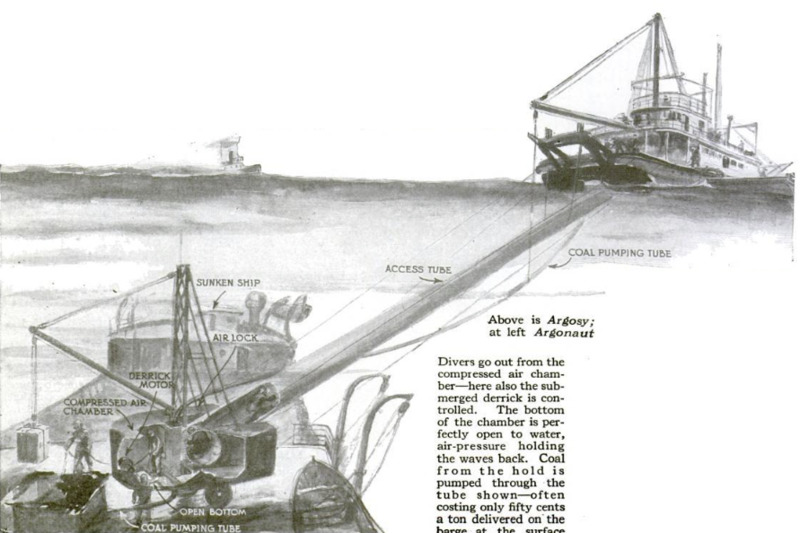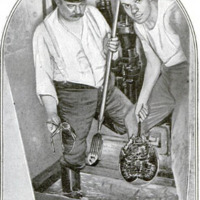-
Title (Dublin Core)
-
A Visit to Davy Jones's Locker. Going down in a submarine - Walking on the bed og the ocean - How the war's lost ships are to be recovered
-
Article Title and/or Image Caption (Dublin Core)
-
A Visit to Davy Jones's Locker. Going down in a submarine - Walking on the bed og the ocean - How the war's lost ships are to be recovered
-
extracted text (Extract Text)
-
GETTING down into
thesubmarine Argo-
nawt is no very diffi-
cult process. You clamber
up into an open hatchway
at the front of the Argosy,
and find yourself at the
mouth of a huge steel pipe,
four and a half feet in
diameter. Descending the
pipe is a good deal like go-
ing down an ordinary stair-
way. Really, it is a kind of
half-ladder, half-stairway. Angle-irons
riveted to the wall are the steps.
After descending about ten feet you
find yourself at an elbow in the pipe.
It stops going straight down and heads
off toward the Argonaut, the particular
angle downward depending on the
amount she happens to be submerged
at the moment. Electric lights illumi-
nate the passageway.
At the far end is a steel wall barring
progress. At the right, however, and
within the huge joint which holds the
access tube to the Argonaut, there is a
round opening, about two feet in di-
ameter, which leads to the “air-lock,”
a chamber about seven feet long, three
feet wide, and four and a half feet high.
At the far end of the air-lock is the door
leading to the actual working chamber
itself. This door is closed. There is a
heavy air-pressure on the other side—
needed to prevent the water from
entering through the hole in the
floor of the working chamber. This is
about four feet by two and a quarter
feet in size. Through it the actual
operations on the bottom of the ocean
or on a submerged ship are carried on. -
As is evident, the air-pressure in the
little room you have just crawled into
must equal that within the actual
working chamber itself, or you would
never get the door between the two
open. This is precisely what this little
room, the “air-lock,” is for. Like the
lock in a canal through which a ship
passes to gain a higher level, so this
air-lock exists to raise the air-pressure
that surrounds you up to the higher
level of that within the working cham-
ber. The door between you and the
latter is thirty-eight inches long by
twenty-three inches wide—say 875
square inches in total area. For every
foot that one goes down into the
water, the pressure increases by .434
pounds. If one were down 25 feet
then, the pressure would be 10.85
pounds per square inch more than
the approximately fifteen
pounds per square inch al-
‘ways on the earth’s surface.
If the door has an area of
875 square inches, as we
figured, and there is a push
of 10.85 pounds on each
square inch, it appears that
there is a total of 8,750
pounds pushing on the
whole door, roughly—about
four and a half tons! Obvi-
ously you couldn’t get the
door open and yourself into the operat-
ing chamber without the use of this in-
tervening air-lock. Using the, air-lock,
one can get'up a balancing- pressure
and overcome the four and a half tons.
Once inside the air-lock, the door is
closed behind you. It is locked from
the inside. Simon Lake seizes a piece
of heavy iron bar lying on the floor,
and pounds the door and the locks
even tighter. This is to make sure
no air escapes. He then turns a valve.
It gives you a creepy sensation—
turning that valve. You know how a
chicken must feel when he sees the axe
descending. But it is only momentary.
In comes the air. P-
tsh-h-h—sh-h-h-h-h-h-h-h-h.
It is the same kind of a |
sound, though not quite so |
great in volume, that a |
locomotive makes when it
draws up to a station and
the safety valve starts to
blow off because the engi- |
neer is no longer using the
steam. in his cylinders.
In that little room the |
noise is deafening.
Suddenly the air is shut |
off. Inthe meantime you
have been swallowing, pinching your
nese, and endeavoring to get the Eus-
tachian tubes that lead from your
throat to your ears under the same air-
pressure as that coming into the room.
Otherwise your ear-drums would pro-
test unmistakably against the pressure.
Mr. Lake has shut off the air, so
you may have a few moments in which
to accustom yourself to the increased
pressure. Then he reaches for the
valve again.
P-t-sh-h-h-h-h! On it comes again.
In a few moments it begins to lose its
sharp whistle, eases off into a long-
drawn-out sigh, and then ceases alto-
gether. The reason for this is that the
air has been coming ‘rom the
working chamber, and now
ceases because the pressures in
the two rooms have become
equal. Obviously it should
now be possible to open the
door connecting the two. You
find that Mr. Lake is already
pounding on the doors latches.
Afew more pounds, and presto!
the door swings ‘open. The
air-lock has served its purpose
—let you conquer the barrier.
You and the others scramble
through the opening.
You find yourself in a little
steel-riveted, steel-plated room,
shaped as to floor and ceiling a
good deal like the bottom of a
fiat-iron, and about seven feet
high. In reality it is the
grow of the underwater boat.
is accounts for its triangular
or flat-iron shape.
The Hole in the Floor
But the thing that attracts
your attention above all else in
the room is a hole in the floor
about two and a fourth by four
feet. There is water in that
hole. There are all kinds of
shells lying down there, stones,
and many weird objects.
It's the bottom of the ocean
you're looking at. Suddenly
some kind of sea-denizen that
probably calls himself a crab
of a sort heaves into view. He
has a shell on his back, and
four or five legs sticking out on each
side, and all told, legs and all, he is
about as big as the palm of your hand.
Evidently local society down here dis-
dains to go forward and backward as
is the custom in regions above, for he
or she locomotes sideways, and really
can dart through the water at a re-
markable pace even though side-
stepping it all the while. Interesting
customs the natives have down here.
A fish comes plowing into view. He
apparently doesn’t like the scenery
just above him, and veers off and out
of sight. It’s lucky for him he did, for
Mr. Lake is already standing over the
opening, waiting, a spear in his hand,
for anything that may come along.
Look! Here comes something
crawling over the bed of the sea. It
looks like an army tank headed for
somewhere. It has a big horseshoe-
shaped shell, and you can't see any
legs, or wheels, or anything under it.
You wonder how it gets along. Down
shoots Mr. Lake's spear and Mr. or
Mrs. Sea Tank is impaled as easily as
if Mr. Lake had been aiming for the
middle of a fried egg with a table fork.
Up comes spear, sea tank and all. It
proves to be a huge horseshoe crab,
more than a foot across. What appear
to be about two dozen legs wave wildly
from each side of the shell as you pull;
it off the spear. You put the crab
bottom upward on the floor of the
boat where it can kick up its heels to
its heart's content, and no harm done,
for it is in the same predicament a
turtle is when turned over on its back.
It dawns on you that you have for-
gotten you are under considerable air-
pressure. It has all been so interest-
ing, looking down through that open-
ing on to the bed of the ocean, you
have forgotten all about anything else.
The truth is, the air-pressure within
the far corners of your lungs, and at
the back of your ear-drums has be-
come the same as that within the
room, and, except for a general sensa-
tion of heaviness, it is not noticeable.
Standing in that chamber and look-
ing through the opening in the floor,
one can realize very readily how it
would be if one happened to pass over
asubmerged wreck. Nearly the whole
vessel would stand out as plainly as a
board at the bottom of a brook. Itis
really remarkable how much light gets
to the bottom of the sea at ordinary
depths. Most sea water, Mr. Lake
says, is quite clear, in spite of the fact
that one has a hard time realizing it
when trying to look down into it from
a boat at the surface. In Southern
waters, particularly, one can fre-
quently see two or three hundred feet
with ease.
To Salvage Wrecks
Had there been wrecks close
at hand in Bridgeport Harbor,
it would have been possible to
get over one, and perhaps walk
on its deck. As it is, you may
take off your shoes and stock-
ings and stand in the opening,
walking on the bed of the
ocean as the submarine moves
along. You can get a very
good idea of how easy it would
be to size up the condition of a
sunken ship, get things from
its interior, send out divers,
and otherwise work with it,
almost as easily as if it were
but two or three feet under the
surface. You have to concede
that Simon Lake has turned
out an exceedingly practical
contrivance; and one of strik-
ing originality.
‘What Mr. Lake is going to
do with his Argosy and Argo-
naut is perhaps best made
evident by the following quota-
tions from his book, “The
Submarine in War and Peace”:
Somewhere off Bridgeport,
Conn,, lies the wreck of the old
Sound steamer Lezington. Tradi-
tion has it that she has a fortune in
her safe. Many a ship has been
sunk in the waters about Hell
Gate; search was carried on there
for years for the old British
frigate Hussar, which struck on
Pot Rock and sank during the Revolution-
ary War. They tell that she had four
million dollars (£820,000) in gold on board
to pay off the British troops, and that she
carried this treasure to the bottom with
her. There is a cargo of block tin in a
barge somewhere off the Battery, New
York, and many a ship with valuable cargo
lies along the coast from Newfoundland to
Key West. The yearly loss in ships and
cargoes throughout the world has always
run into’many millions of dollars, and since
the war this has been multiplied a hundred-
fold, amounting to billions. The time will
come when many of these ships will be
found, and such of their cargo as is still
valuable will be salvaged.
“Ships like the Argosy and Argonaut
will get this booty,” says Mr. Lake.
-
Contributor (Dublin Core)
-
Lloyd E. Darling (writer)
-
Language (Dublin Core)
-
eng
-
Date Issued (Dublin Core)
-
1919-10
-
pages (Bibliographic Ontology)
-
78-79
-
Rights (Dublin Core)
-
Public domain (Google digitized)
-
Archived by (Dublin Core)
-
Davide Donà
-
Alberto Bordignon (Supervisor)
 Popular Science Monthly, v. 95, n. 4, 1919
Popular Science Monthly, v. 95, n. 4, 1919




